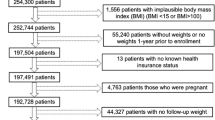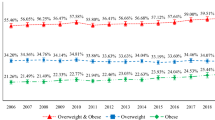Abstract
Background/Objectives:
To examine how a woman’s current body mass index (BMI) is associated with nonrandom residential migration that is based on the average BMI of her origin and destination neighborhoods.
Subjects/Methods:
Among women having at least two children, all birth certificates from Salt Lake county from 1989 to 2010 (n=34 010) were used to obtain prepregnancy weights before the first and second births, residential location and sociodemographic information. Census data were used for measures of walkability of neighborhoods.
Results:
After adjustments for age, education, race/ethnicity and marital status, obese women living in the leanest neighborhoods are found to be three times more likely (odds ratio (OR)=3.03, 95% confidence interval (CI) 2.06–4.47) to move to the heaviest neighborhoods relative to women with healthy weight (BMI between 18 and 25 kg m−2). Conversely, obese women in the heaviest neighborhoods are 60% less likely (OR=0.39, 95% CI 0.22–0.69) to move to the leanest neighborhoods relative to healthy weight women. Indicators of relatively greater walkability (older housing, greater proportion of residents who walk to work) and higher median family income characterize leaner neighborhoods.
Conclusions:
The findings are consistent with the hypothesis that nonrandom selection into and out of neighborhoods accounts for some of the association between BMI and neighborhood characteristics.
This is a preview of subscription content, access via your institution
Access options
Subscribe to this journal
Receive 12 print issues and online access
$259.00 per year
only $21.58 per issue
Buy this article
- Purchase on Springer Link
- Instant access to full article PDF
Prices may be subject to local taxes which are calculated during checkout

Similar content being viewed by others
References
Yang L, Colditz GA . Prevalence of overweight and obesity in the United States, 2007-2012. JAMA Intern Med 2015; 175: 1412–1413.
Flegal KM, Graubard BI, Williamson DF, Gail MH . Cause-specific excess deaths associated with underweight, overweight, and obesity. JAMA 2007; 298: 2028–2037.
Cervero R, Kockelman K . Travel demand and the 3Ds: density, diversity, and design. Transp Res D Transp Environ 1997; 2: 199–219.
Black JL, Macinko J . Neighborhoods and obesity. Nutr Rev 2008; 66: 2–20.
Grafova IB, Freedman VA, Kumar R, Rogowski J . Neighborhoods and obesity in later life. Am J Public Health 2008; 98: 2065–2071.
Berke EM, Koepsell TD, Moudon AV, Hoskins RE, Larson EB . Association of the built environment with physical activity and obesity in older persons. Am J Public Health 2007; 97: 486–492.
Ross NA, Crouse D, Tremblay S, Khan S, Tremblay M, Berthelot J-M . Body mass index in urban Canada: neighborhood and metropolitan area effects. Am J Public Health 2007; 97: 500–508.
Booth KM, Pinkston MM, Poston WSC . Obesity and the built environment. J Am Diet Assoc 2005; 105: S110–S117.
Papas MA, Alberg AJ, Ewing R, Helzlsouer KJ, Gary TL, Klassen AC . The built environment and obesity. Epidemiol Rev 2007; 29: 129–143.
Mackenbach JD, Rutter H, Compernolle S, Glonti K, Oppert J-M, Charreire H et al. Obesogenic environments: a systematic review of the association between the physical environment and adult weight status, the SPOTLIGHT project. BMC Public Health 2014; 14: 1–28.
Frank LD, Saelens BE, Powell KE, Chapman JE . Stepping towards causation: do built environments or neighborhood and travel preferences explain physical activity, driving, and obesity? Soc Sci Med 2007; 65: 1898–1914.
Saelens BE, Sallis JF, Frank LD . Environmental correlates of walking and cycling: findings from the transportation, urban design, and planning literatures. Ann Behav Med 2003; 25: 80–91.
Pinjari AR, Bhat CR, Hensher DA . Residential self-selection effects in an activity time-use behavior model. Transp Res B Method 2009; 43: 729–748.
Smith KR, Zick CD, Kowaleski-Jones L, Brown BB, Fan JX, Yamada I . Effects of neighborhood walkability on healthy weight: Assessing selection and causal influences. Soc Sci Res 2011; 40: 1445–1455.
Zick CD, Hanson H, Fan JX, Smith KR, Kowaleski-Jones L, Brown BB et al. Re-visiting the relationship between neighbourhood environment and BMI: an instrumental variables approach to correcting for residential selection bias. Int J Behav Nutr Phys Act 2013; 10, 27.
Brasington DM . Housing choice, residential mobility, and hedonic approaches. In: Fischer MM, Nijkamp P (eds) Handbook of Regional Science. Springer-Verlag, Berlin: Heidelberg, Germany, 2014, pp 147–165.
Jansen SJT . Different values, different housing? Can underlying value orientations predict residential preference and choice? Hous Theor Soc 2014; 31: 254–276.
Bhat CR, Guo JY . A comprehensive analysis of built environment characteristics on household residential choice and auto ownership levels. Transp Res B Methodol 2007; 41: 506–526.
Boone-Heinonen J, Gordon-Larsen P, Guilkey DK, Jacobs DR, Popkin BM . Environment and physical activity dynamics: the role of residential self-selection. Psychol Sport Exerc 2011; 12: 54–60.
Boone-Heinonen J, Guilkey DK, Evenson KR, Gordon-Larsen P . Residential self-selection bias in the estimation of built environment effects on physical activity between adolescence and young adulthood. Int J Behav Nutr Phys Act 2010; 7: 70.
Cao X, Mokhtarian PL, Handy SL . Examining the impacts of residential self-selection on travel behaviour: a focus on empirical findings. Transp Rev 2009; 29: 359–395.
Mokhtarian PL, Cao X . Examining the impacts of residential self-selection on travel behavior: a focus on methodologies. Transp Res B Methodol 2008; 42: 204–228.
Lee IM, Ewing R, Sesso HD . The built environment and physical activity levels. The Harvard Alumni Health Study. Am J Prev Med 2009; 37: 293–298.
Hou N, Popkin BM, Jacobs DR, Song Y, Guilkey D, Lewis CE et al. Longitudinal associations between neighborhood-level street network with walking, bicycling, and jogging: the CARDIA study. Health Place 2010; 16: 1206–1215.
Berry TR, Spence JC, Blanchard C, Cutumisu N, Edwards J, Nykiforuk C . Changes in BMI over 6 years: the role of demographic and neighborhood characteristics. Int J Obes 2010; 34: 1275–1283.
Cao X . Examining the impacts of neighborhood design and residential self-selection on active travel: a methodological assessment. Urban Geogr 2015; 36: 236–255.
Giles-Corti B, Bull F, Knuiman M, McCormack G, Van Niel K, Timperio A et al. The influence of urban design on neighbourhood walking following residential relocation: longitudinal results from the RESIDE study. Soc Sci Med 2013; 77: 20–30.
Ludwig J, Sanbonmatsu L, Gennetian L, Adam E, Duncan GJ, Katz LF et al. Neighborhoods, obesity, and diabetes—a randomized social experiment. N Engl J Med 2011; 365: 1509–1519.
Plantinga AJ, Bernell S . Can urban planning reduce obesity? The role of self-selection in explaining the link between weight and urban sprawl. Rev Agric Econ 2007; 29: 557–563.
Zick CD, Hanson H, Fan JX, Smith KR, Kowaleski-Jones L, Brown BB et al. Re-visiting the relationship between neighbourhood environment and BMI: an instrumental variables approach to correcting for residential selection bias. Int J Behav Nutr Phys Act 2013; 10: 27.
Powell-Wiley TM, Ayers C, Agyemang P, Leonard T, Berrigan D, Ballard-Barbash R et al. Neighborhood-level socioeconomic deprivation predicts weight gain in a multi-ethnic population: longitudinal data from the Dallas Heart Study. Prev Med 2014; 66: 22–27.
Halonen JI, Kivimaki M, Pentti J, Stenholm S, Kawachi I, Subramanian SV et al. Green and blue areas as predictors of overweight and obesity in an 8-year follow-up study. Obesity (Silver Spring) 2014; 22: 1910–1917.
Gibson DM . The neighborhood food environment and adult weight status: estimates from longitudinal data. Am J Public Health 2011; 101: 71–78.
Sampson R, Sharkey P . Neighborhood selection and the social reproduction of concentrated racial inequality. Demography 2008; 45: 1–29.
Sampson RJ . Moving to inequality: neighborhood effects and experiments meet social structure. Am J Sociol 2008; 114: 189–231.
Schachter J . Why People Move: Exploring the March 2000 Current Population Survey. Census Bureau: Washington, DC, USA, 2001.
Morris DS, Schubert SS, Ngo DL, Rubado DJ, Main E, Douglas JP . Using state-issued identification cards for obesity tracking. Obes Res Clin Pract 2014; 9: 87–91.
Salt Lake County, Utah, Census 2000 Demographic Profile Highlights, Summary File 3 (database on the Internet). 2000 [cited 21 January 2008). Available from: http://factfinder.census.gov.
Smith KR, Brown BB, Yamada I, Kowaleski-Jones L, Zick CD, Fan JX . Walkability and body mass index: density, design, and new diversity measures. Am J Prev Med 2008; 35: 237–244.
Brown BB, Smith KR, Hanson H, Fan JX, Kowaleski-Jones L, Zick CD . Neighborhood design for walking and biking: physical activity and body mass index. Am J Prev Med 2013; 44: 231–238.
Reschovsky C . Journey to Work: 2000. Census Bureau: USA, 2004.
County USCBSL. U.S. Census Bureau: Salt Lake County, Utah, Census 2000 Demographic Profile Highlights, Summary File 3. In: Salt Lake County, Utah, Census 2000 Demographic Profile Highlights, Summary File 3, 2000. Available at: http://factfinder.census.gov.
Craig CL, Brownson RC, Cragg SE, Dunn AL . Exploring the effect of the environment on physical activity - a study examining walking to work. Am J Prev Med 2002; 23: 36–43.
Southworth M, Ben-Joseph E . Street standards and the shaping of suburbia. JAPA 1995; 61: 65–81.
Berrigan D, Troiano R . The association between urban form and physical activity in U.S. adults. Am J Prev Med 2002; 23 (2 S): 74–79.
Mackenbach JD, Rutter H, Compernolle S, Glonti K, Oppert JM, Charreire H et al. Obesogenic environments: a systematic review of the association between the physical environment and adult weight status, the SPOTLIGHT project. BMC Public Health 2014; 14: 233.
Leal C, Chaix B . The influence of geographic life environments on cardiometabolic risk factors: a systematic review, a methodological assessment and a research agenda. Obes Rev 2011; 12: 217–230.
Colditz GA, Willett WC, Rotnitzky A, Manson JE . Weight gain as a risk factor for clinical diabetes mellitus in women. Ann Intern Med 1995; 122: 481–486.
Resnick HE, Valsania P, Halter JB, Lin X . Relation of weight gain and weight loss on subsequent diabetes risk in overweight adults. J Epidemiol Community Health 2000; 54: 596–602.
Knowler WC, Fowler SE, Hamman RF, Christophi CA, Hoffman HJ, Brenneman AT et al. 10-year follow-up of diabetes incidence and weight loss in the Diabetes Prevention Program Outcomes Study. Lancet 2009; 374: 1677–1686.
Ewing R, Schmid T, Killingsworth R, Zlot A, Raudenbush S . Relationship between urban sprawl and physical activity, obesity, and morbidity. Am J Health Promot 2003; 18: 47–57.
Kelly-Schwartz AC, Stockard J, Doyle S, Schlossberg M . Is sprawl unhealthy? A multilevel analysis of the relationship of metropolitan sprawl to the health of individuals. J Planning Ed Res 2004; 24: 184–196.
Penney TL, Rainham DGC, Dummer TJB, Kirk SFL . A spatial analysis of community level overweight and obesity. J Hum Nutr Diet 2014; 27: 65–74.
Acknowledgements
This research was supported by the NIH NIDDK Grant Number R21 DK080406. The funding agency had no involvement in study design, data analysis, interpretation of the results or decision to submit this article for publication. The findings and conclusions in this paper are those of the authors and do not necessarily represent the views of the National Institutes of Health. We thank Alison Fraser, Cindy Brown, Diana Lane Reed and Jennifer West for their assistance with data and project management as well as the Pedigree and Population Resource of the Huntsman Cancer Institute, University of Utah (funded by the Huntsman Cancer Foundation), for its role in the ongoing collection, maintenance and support of the Utah Population Database (UPDB). We appreciate the comments of two anonymous reviewers and the editor for suggestions on an earlier draft.
Author information
Authors and Affiliations
Ethics declarations
Competing interests
The authors declare no conflict of interest.
Additional information
Supplementary Information accompanies this paper on International Journal of Obesity website
Supplementary information
Rights and permissions
About this article
Cite this article
Smith, K., Hanson, H., Brown, B. et al. Movers and stayers: how residential selection contributes to the association between female body mass index and neighborhood characteristics. Int J Obes 40, 1384–1391 (2016). https://doi.org/10.1038/ijo.2016.78
Received:
Revised:
Accepted:
Published:
Issue Date:
DOI: https://doi.org/10.1038/ijo.2016.78



